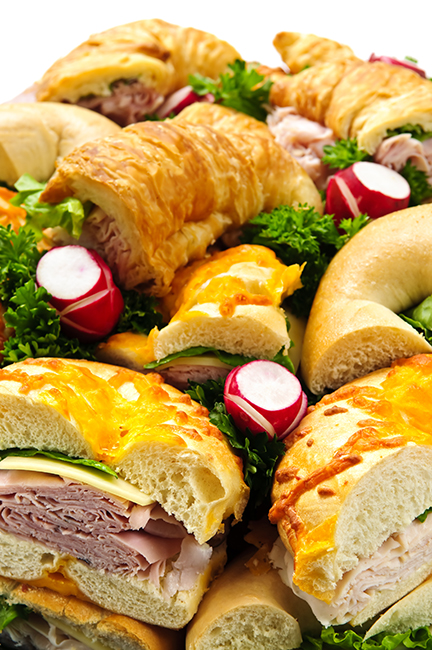In my second year of business, I received a call from Mary, who wanted us to cater a luncheon for 500 people at The State House in Boston. It was a high-profile event that could lead to more business, and I was excited and nervous about the opportunity. It would definitely be the biggest job I had catered thus far—but there was a catch. Our initial conversation went something like this:
Mary: Hi, a colleague recommended your company to me. I need to organize a lunch at The State House next week for at least 500 people. Can you handle that size group?”
Me: Absolutely. (Note: I hoped my tone didn’t betray the fear that had gripped every bone in my body.)
So we began discussing the specifics: the day, place, time, budget, and menu. Then I asked, “When can you confirm the final number of people?”
Mary: “Well that’s the tricky part. I won’t know that for sure until the lunch actually gets going.”
Me: Ahh…ok…I’m sorry, could you elaborate on that?
Mary: These lunches at can be unpredictable. We never know for certain how many people are going to show up. What I usually do is order and pay for 500, and about a half-hour into the lunch, I let you know if we will need more food and you bill us the difference.
Me: OK…could you give me a sense of how many more people you might need food for?
Mary: Anywhere from 50 to 200.
Me: Hmm… getting you more food isn’t a problem. I can have my staff on stand-by, but if you end up needing a couple hundred more sandwiches, it will take some time to produce and deliver them.”

At this point I sensed that Mary was getting bored with our conversation. She gave a quick sigh and said, “I have been doing these lunches forever. Quite frankly, they are a thorn in my side, and I really don’t care about the logistics. I just want to get these savages (her word) fed, and move them along to their next event. The caterer that I usually order from gets whatever additional food we need over here pretty quickly. I don’t know how they do it, and quite frankly, I don’t care. I realize it’ll take more than five minutes, but it can’t take a half-hour. We may not even need any extra at all. But if it’s something you’d rather not deal with, I understand completely.”
She was a woman who knew what she wanted, and didn’t mince words expressing it.
Me: We definitely want to cater this lunch for you, Mary.
Mary: Good, I have to run. Let’s talk at the end of the week.
Before I could say goodbye, she hung up.
The next few days were spent planning and worrying. How would we pull this off? It wasn’t so much the number of people that concerned me, but rather the “I’ll let you know half-way through lunch if we need a couple of hundred more sandwiches” part that was keeping me up at night.
Event execution
There were three issues I needed to determine.
First, how much backup/extra sandwich prep would we have on hand (sliced meats, cheeses, tuna and chicken salads, bread, condiments)? I decided on splitting her estimate and adding a little extra. We would prep for an additional 150.
Second, how much staff was required if additional sandwiches were needed? We would be in the middle of the lunch rush—not an ideal time to pull people off the floor. I decided to pad my lunch crew with extra staff who would be available to bang out up to 200 sandwiches quickly.
Third, how much personnel would I need to deliver and set-up round #1, and potentially round #2, to the State House? I contacted a temporary staffing agency and arranged for four servers to arrive at my restaurant a couple of hours before lunch. They would haul everything over to the State House, accompanied by someone from my staff, who would manage the set-up.
True to her word
Mary called as promised 30 minutes into the luncheon, needing food for “about 100 more people” (= 10 platters of sandwiches). I instructed two of the servers to hightail it back to the restaurant (which luckily was just around the corner). By the time they arrived, two of the 10 platters were done.
Anxious to return to The State House, one of the servers, with more than a hint of panic in his voice asked, “How long’s it gonna be?”
“We’ll be done in 15 minutes,” a sandwich maker responded. “Take these for now,” he said, handing off the two trays of 20 total sandwiches.
“This is it?” the server cried out, followed by the line that to this day, brings a smile to my face: “This is like feedin’ a tic-tac to a whale!”
Lessons learned
• During my initial call with Mary, I was curious as to why she decided to try a new caterer for such a large event. I wanted to ask but honestly, I was too afraid of her. While I never did find out, the good news is that she booked the same event with us every year after.
However, if I took the same call today, I would ask, “Mary, I am curious why you’ve decided to change caterers. If there was a specific problem you experienced, I’d like to know what it was so we do not repeat it.”
• If Mary had not needed any additional food, we would have used the ham, turkey, roast beef, and cheese for the next day or two’s catering and restaurant orders. Then we would have frozen what, if anything, remained.
• I had pre-arranged with the produce company they would take back any cases of lettuce and tomatoes that were not opened.
• This experience is a good example of an appropriate time to “go for it,” and hopefully take a catering business to the next level. I felt I had enough experience with this type of lunch and a solid crew to go beyond my comfort zone and pull it off. Granted, there were new challenges to get through, but all in all, it was a success. It gave me confidence to take on more jobs this size.



